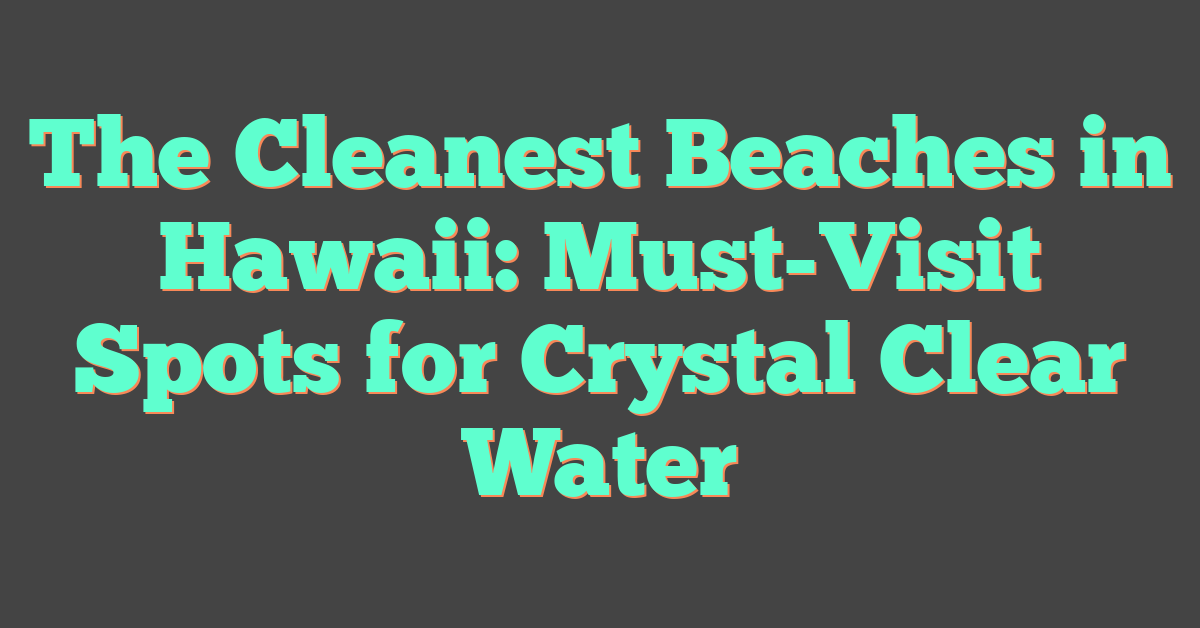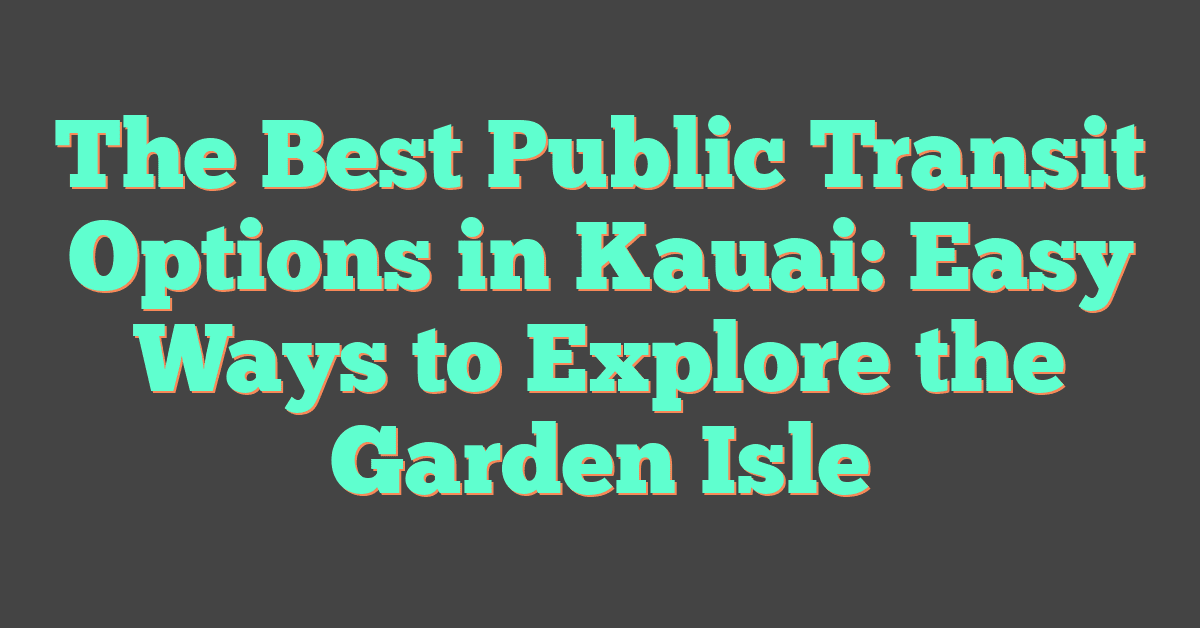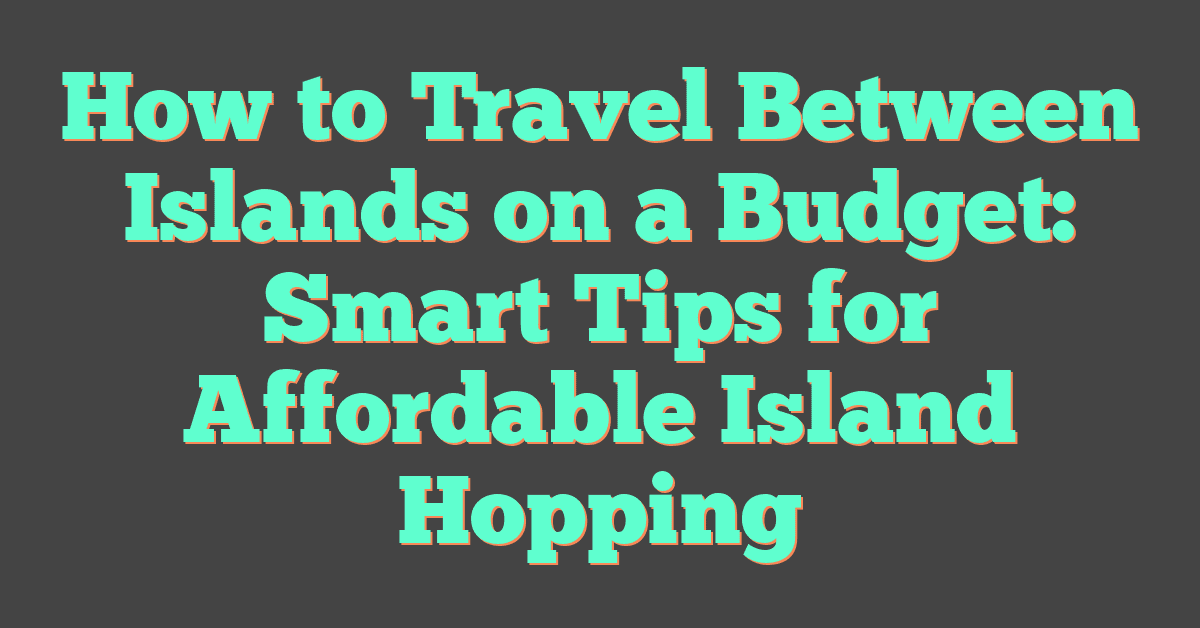When I think of paradise, I picture clean beaches with soft sand and sparkling water. Hawaii offers some of the cleanest and most beautiful beaches in the world.

Many beaches in Hawaii have clear, turquoise water and spotless shores. These spots are perfect for swimming and relaxing.

I love visiting places where I can enjoy the sun without worrying about dirty sand or cloudy water. Hapuna Beach and Lanikai Beach stand out for their cleanliness and natural beauty.
Some of these beaches offer great snorkeling thanks to clear water and healthy reefs. If you’re searching for the best spots to dip your toes in clean water and unwind, Hawaii has many options.
What Makes a Beach Clean in Hawaii?

When I think of a clean beach in Hawaii, certain features stand out. The best beaches have sparkling clear water, soft white sand, and plenty of sea life with healthy coral reefs nearby.
Crystal-Clear Water and Turquoise Blue Water
For me, nothing says “clean beach” like seeing the ocean bottom through crystal-clear water. In Hawaii, the clearest water appears on open coastline beaches far from rivers, towns, or large crowds.
These areas have little runoff or pollution, so the water stays pure most of the year. Bright sunlight makes the turquoise blue water look vibrant and inviting.
When I walk into the ocean at a clean Hawaiian beach, I can spot fish swimming below and see the patterns in the sand. Popular spots like Hapuna Beach and many North Shore beaches offer this kind of visibility.
Local programs monitor bacteria, runoff, and pollution to keep the water clean. Their efforts protect the status of these beaches as some of the clearest water in Hawaii.
Soft Powdery White Sand
A clean Hawaiian beach usually has soft, powdery white sand. This sand feels smooth between my toes and doesn’t stick to my skin.
Its white color comes mostly from ground coral and shells. I rarely see litter, tar, or seaweed piled up.
Local communities and visitors keep the sand clean with regular beach cleanups. The lack of trash means the sand stays natural and beautiful.
Powdery white sand also keeps the beach cooler under the sun. It reflects light and makes the area feel brighter and more welcoming.
Hapuna Beach and other top spots are known for these soft sand qualities.
Abundant Marine Life and Coral Reefs
Healthy marine life shows that a beach is truly clean. I love watching colorful fish and sea turtles swimming near the shore.
If the beach has abundant marine life, the water and sand are free of chemicals and pollutants. Coral reefs create calm shallow swimming areas by breaking waves.
Their colorful structures are home to many fish and reef animals. A clean, living reef close to shore means the water is healthy.
I often see snorkelers enjoying these undersea views. The presence of thriving coral and sea life shows that local groups care about protecting the ocean.
Top Picks: The Cleanest Beaches by Island
The cleanest beaches in Hawaii stand out for their clear water, soft sand, and beautiful views. Each island offers something different, from calm family spots to excellent snorkeling beaches.
Oahu: Lanikai Beach, Kailua Beach, Waikiki Beach, Ko Olina Beach
On Oahu, I find Lanikai Beach stunning for its clear blue water and soft sand. It’s not very crowded on weekdays, and I can paddle out to the twin Mokulua Islands or relax by the shore.
Kailua Beach is close to Lanikai and has long white sands and steady breezes, perfect for kayaking and windsurfing. The water feels fresh and inviting all year.
Waikiki Beach is famous and busier, but frequent maintenance keeps it clean. The views of Diamond Head are iconic, and the gentle waves are great for beginners learning to surf.
Ko Olina Beach has manmade lagoons and a manicured landscape. It’s a perfect spot for calm swimming and clear water, especially with kids.
Maui: Kapalua Bay, Kaanapali Beach, Makena Beach, Maluaka Beach
Kapalua Bay stands out for its protected, crescent-shaped beach and crystal-clear water. Snorkeling is popular here because of the colorful fish near the rocky sides.
Kaanapali Beach offers a three-mile stretch of golden sand and clear, gentle waves. There are several resorts along the beach, but it still feels peaceful in the early morning.
Makena Beach, also called Big Beach, is one of the largest on Maui. The sand is deep and clean, and the waves can be powerful, so I swim only when the tide is calm.
Maluaka Beach is less crowded and sits near the south end of Wailea. Its calm, blue water makes it one of the best places for snorkeling, and I sometimes spot sea turtles here.
Big Island: Hapuna Beach, Mauna Kea Beach, Kua Bay, Manini’owali Beach
Hapuna Beach is famous for its wide, white sand and clear blue water. It’s great for families because the swimming is easy, especially in summer.
Mauna Kea Beach, also called Kauna‘oa Bay, has soft sand and gentle, turquoise waves. The beach is part of a hotel property, so parking is limited, but that keeps crowds low and the area very clean.
Kua Bay, known locally as Manini’owali Beach, features strikingly clear and bright blue water. The beach is a little harder to reach, but it’s worth it for the clear water and excellent snorkeling.
Manini’owali Beach is another name for Kua Bay and is known for its powdery white sand and quiet setting. The lack of big crowds helps keep the beach clean and the water sparkling.
Kauai: Hanalei Bay, Ke’e Beach, Anini Beach, Poipu Beach
Hanalei Bay is a large crescent on Kauai’s north shore, framed by green mountains. I love walking the long stretch of sand, and the water is usually calm during the summer.
Ke’e Beach sits at the end of the road on the island’s north side. It offers amazing views and is the gateway to the Napali Coast.
The reef helps keep the water clear, especially in the summer. Anini Beach has some of the calmest waters on the island, thanks to its long fringing reef.
It’s my favorite spot for safe swimming and snorkeling, even with kids. Poipu Beach, on the south shore, is a family-friendly beach with clear, shallow water.
The sand is golden, and I often see Hawaiian monk seals resting in the sun.
Lanai: Hulopoe Beach
Hulopoe Beach is the top choice on Lanai and is easily accessible from the ferry dock. The water here is clean and usually calm, perfect for swimming and snorkeling.
Sometimes, I spot dolphins playing in the bay. There are tide pools on one side of the beach, which are fun to explore.
I also enjoy relaxing on the wide, soft sand, with views of cliffs and the open ocean. The quiet setting makes it easy to enjoy the natural beauty all day.
Best Activities for Beach Lovers
Hawaii’s beaches offer many ways to enjoy the sun, sand, and ocean. Whether I want relaxation or adventure, I find something for every mood at these beautiful clean beaches.
Swimming and Sunbathing
The warm, gentle waters make swimming comfortable for people of all skill levels. I love how places like Hapuna Beach and Lanikai Beach have clear and calm water, perfect for floating or practicing my strokes.
Top Spots for Swimming:
- Waikiki Beach (easy for beginners)
- Poipu Beach (lifeguard on duty)
- Kailua Beach (soft sand and shallow entry)
When I sunbathe, I always bring sunscreen and a big hat because the UV index in Hawaii can be high all year. Soft sands and steady trade winds help keep me cool as I rest and listen to the sound of the waves.
Snorkeling and Spotting Green Sea Turtles
Snorkeling is one of my favorite ways to explore Hawaii’s underwater life. Beaches like Anini, Ke’e, and Lanikai Beach have very clear water, which helps me see fish, coral, and sometimes even sea turtles up close.
I use a well-fitting mask and bring my own snorkel gear to avoid long rental lines. In places such as Poipu Beach and Hanauma Bay, I’ve watched green sea turtles glide through the water or rest on the sand.
Tips for Snorkeling:
- Stay calm and move slowly.
- Never touch sea turtles or coral.
- Go early in the day for better visibility.
Surfing and Boogie Boarding
For more excitement, I grab my board and join the surfers at beaches like Waimea Bay or Waikiki. These spots offer waves fit for both beginners and experts.
If I’m new to surfing, I start on smaller waves in Waikiki, where there are plenty of surf schools and friendly instructors. Boogie boarding is also fun at many beaches, like Hapuna Beach, where gentle slopes make catching waves easier for me.
What I Like About These Activities:
- Surfing lets me challenge myself against the ocean.
- Boogie boarding is easier to learn and fun for all ages.
- Both sports help me enjoy the power and beauty of Hawaii’s clean shoreline.
Nature and Wildlife Encounters
Hawaii’s beaches are as famous for their clear water as they are for amazing wildlife. I often find that exploring the shores and reefs lets me see creatures I can’t find anywhere else, from playful dolphins to colorful fish and gentle monk seals.
Dolphins and Spinner Dolphins
When I visit beaches on Oahu and the Big Island, I sometimes spot dolphins in the wild. Spinner dolphins are especially exciting to watch because of their acrobatic jumps and spins above the water.
Early morning is usually the best time to see them cruising along the coast. Tour guides often launch boats from the west and north shores, giving me a better chance to see these playful animals.
I follow the rules to avoid disturbing the dolphins. Watching from a respectful distance keeps dolphins safe and relaxed in their home.
The Hawaiian Spinner Dolphin performs spinning leaps, often near Waianae or Makua Beach. Sometimes they come close to shore for a rest at places like Hanauma Nature Preserve.
Reef Fish and Marine Life Observation
Snorkeling in Hawaii lets me see a huge variety of reef fish. Many are brightly colored and found only on these islands.
Parrotfish, butterflyfish, and yellow tangs are common sights. The coral reefs around Hanauma Bay and Lanikai Beach often give me clear views of these fish.
I always follow the posted rules when snorkeling to protect the reef and its wildlife. Not touching coral or fish helps keep the ecosystem strong for everyone.
Sometimes I see sea cucumbers, sea urchins, and even octopus along the reef edges. Some beaches, such as Kailua Beach, offer especially clear water for spotting marine life.
Bringing an underwater camera lets me capture the colors and patterns of these animals.
Monk Seals and Turtle Town
Hawaiian monk seals are rare and endangered, but sometimes I see them resting on sandy beaches during the day. If I am lucky, I spot them on Oahu’s North Shore or in secluded spots on the Big Island.
Volunteers often put up signs and ropes to help the seals relax without disturbance. Turtle Town is the nickname for spots near Maui where green sea turtles gather.
Places like Maluaka Beach let me swim alongside these gentle giants. I always keep at least 10 feet back so I don’t bother them.
Both monk seals and sea turtles are protected by law.
Amenities and Facilities for Visitors

When I visit the cleanest beaches in Hawaii, I want more than just clear water and soft sand. Convenient facilities and safety features make the beach day even better.
Easy access to restrooms, showers, and shaded picnic tables, plus good parking and places to stay, are all important for a stress-free visit.
Restrooms, Showers, and Picnic Tables
At popular beaches like Hapuna Beach and Kaanapali Beach, I often find clean restrooms and outdoor showers just steps from the sand. This helps when I want to rinse off saltwater before heading home or grabbing lunch.
Many beach parks have shaded picnic tables, perfect for relaxing or taking a break from the sun. I’ve enjoyed picnics here with friends and family, especially at parks that maintain these spaces well.
Some locations, like Hapuna Beach State Recreation Area, offer both restrooms and picnic areas for visitors.
Key Facilities Table
| Facility | Availability | Notable Beaches |
|---|---|---|
| Restrooms | Very Common | Hapuna, Kaanapali, Waikiki |
| Showers | Very Common | Lanikai, Poipu, Kailua |
| Picnic Tables | Common | Hapuna, Poipu, Kailua Beach Park |
Lifeguards and Safety Features
I always feel safer swimming at beaches with lifeguards. At the busiest beaches, like Waikiki or Kaanapali, trained staff watch over swimmers and help if needed.
Some quieter beaches do not have lifeguards, so I pay attention to warning signs and ocean conditions. Emergency phones or marked contact points are at several beach parks.
Certain locations also post safety instructions near the entrances. This makes it easier for me to understand local dangers, like strong currents or jellyfish warnings.
During my visits, I look for flags and signs that show water conditions. I often see clear rules about water safety and first aid services at most well-visited parks.
Parking, Beach Parks, and Hotels
When I choose a beach, I often check if there is good parking. Some beaches have large, organized parking lots, while others offer only roadside spaces that fill up early.
State or county beach parks, like Hapuna Beach State Recreation Area, usually provide marked parking areas and sometimes charge a small fee. This keeps my car close and makes it easy to bring gear, food, and umbrellas.
Many of the cleanest beaches also have nearby hotels or resorts. For example, staying at a hotel next to Kaanapali Beach means I can walk right out to the water.
When I want to stay overnight or enjoy breakfast steps from the shore, these hotels add comfort and convenience. Urban beaches like Waikiki often have both budget and luxury options right along the waterfront.
Hidden Gems: Lesser-Known Pristine Beaches

When I want to escape the crowds, I look for beaches that are clean and peaceful. Hawaii has several hidden gems where I can enjoy clear water, soft sand, and beautiful views.
Makalawena Beach
Makalawena Beach sits on the Big Island and stands out for its calm atmosphere and untouched beauty. I hike about 20 minutes over lava rock to reach it, but the reward is a wide stretch of white sand and clear blue water.
Since the beach is less accessible, it stays cleaner and more tranquil than most popular spots. There are no lifeguards or facilities, so I always bring water, snacks, and anything else I might need.
The waves are usually gentle, which makes it perfect for swimming and wading. I often spot sea turtles basking in the sun, and sometimes I see native birds nearby.
Kauapea Beach
On Kauai’s north shore, Kauapea Beach—often called Secret Beach—is another favorite for peace and cleanliness. It’s harder to find, with a steep trail leading from the road down to the shore.
The hike keeps visitor numbers low, so there’s plenty of space to spread out. The sand here is golden and the water is usually very clean.
Strong waves and rip currents can occur, so I’m always cautious if I plan to swim. Kauapea Beach is also known for its stunning coastal views and tide pools.
I love to watch the sunset from this spot. The scenery is dramatic, with cliffs and lush greenery all around.
Mahukona Beach
Mahukona Beach on the Big Island isn’t a traditional sandy beach, but it’s still one of my picks for pristine waters. The shoreline is mostly rocky, which helps keep the snorkeling area clear since there’s little sand to stir up.
I bring my snorkel gear because the water is calm and home to lots of colorful fish and coral. The old harbor and swimming area are popular with locals, but I never find it crowded.
There are picnic areas and restrooms, which makes it easy for me to spend a few hours relaxing by the water. Because it gets deep gradually, Mahukona is ideal for snorkeling beginners and anyone who enjoys exploring Hawaii’s underwater life.
Ulua Beach
Located in Wailea on Maui, Ulua Beach is famous for its clean sand and excellent snorkeling right near the shore. I like that it’s less crowded than some other Maui beaches, so the atmosphere stays peaceful.
Ulua Beach is good for families thanks to gentle waves and a reef that attracts sea turtles and many tropical fish. It has showers, restrooms, and plenty of shade from the surrounding trees.
I often walk along the short coastal path next to the beach for more pretty ocean views. With easy access and crystal-clear water, Ulua Beach feels like the perfect mix of comfort and natural beauty.
Family-Friendly Clean Beaches

When I visit clean beaches in Hawaii, I look for places where kids can play safely, swim, and enjoy nature. Many beaches offer shallow tide pools, gentle waves, and spots for picnics or camping.
Tide Pools and Wading Areas
Hawaii has beaches with gentle tide pools perfect for kids and families. These tide pools are usually protected by natural rock formations, which makes the water calm and shallow.
Some of the best spots include Baby Beach in Maui and Lanikai Beach on Oahu. These locations have soft sand, clear water, and small pools where I can spot little fish, colorful shells, and sometimes even sea cucumbers.
Wading is safe here because offshore reefs block strong currents. Kids can explore, splash around, and learn about marine life without big waves bothering them.
If I want a place where I can keep a close eye on children while they play, these tide pool areas are my top choice.
Safe Swimming Spots
For me, a beach isn’t family-friendly unless the swimming is safe and the water is clean. Many of Hawaii’s cleanest family beaches have gentle slopes and soft sand with lifeguards on duty.
Waikiki Beach on Oahu is famous for its clear waters, mild waves, and friendly lifeguards. This lets me relax while kids swim, take surf lessons, or try paddleboarding.
Some beaches even have cordoned-off swimming areas to protect against stronger currents and larger waves. Calm spots like Hapuna Beach on the Big Island and Poipu Beach on Kauai offer wide sandy entrances that make it easy for kids to get in and out of the water.
These beaches are known for safe swimming and fun water activities.
Picnicking and Camping
I always enjoy a beach day more when I can bring a picnic or plan a camping trip. Many of Hawaii’s cleanest beaches have shaded picnic tables, barbecues, and grassy areas perfect for get-togethers.
One place I like is Ala Moana Beach Park in Honolulu. It’s clean and safe, with big open areas for kids to play when they’re done swimming.
Many parks and beaches have restrooms and outdoor showers, so I don’t have to worry about sand and salt after a meal or before bedtime. Some family beaches even allow camping with a permit.
This way, I can set up a tent and listen to the waves at night. Camping rules and areas vary by island, so I always check each spot before going.
Preservation and Environmental Efforts

Protecting Hawaii’s beaches means caring for both the land and the people who visit. Local groups, volunteers, and the government work together to keep the sand clean and the coastline healthy for nature lovers and families.
Nature Preserves and Conservation
Nature preserves play an important role on the Hawaiian Islands. They protect unique plants, animals, and ocean life from harm.
Many preserves set clear rules to limit fishing, development, and certain water sports. For example, Hanauma Bay serves as a protected marine life conservation district.
Visitors attend an orientation to learn how to interact with wildlife and avoid stepping on coral reefs. These rules help the reef grow back and keep the water clear for snorkeling.
Groups like the Hawaii Shore and Beach Preservation Association organize projects to restore eroding beaches and protect local habitats. They plant native plants and move sand to help the beaches.
These efforts save beaches that might disappear due to erosion and rising sea levels. The state government supports these projects by approving key restoration programs through the Office of Conservation and Coastal Lands.
Sustainable Tourism Initiatives
Sustainable tourism helps keep Hawaii’s beaches clean. I look for travel programs that teach tourists how to respect the beaches and help protect them.
Sustainable Coastlines Hawaii leads large beach cleanup events. Volunteers removed over 40,000 pounds of debris from the coastlines in just three years.
They focus on both education and action by involving students and visitors in hands-on cleanups. You can read more about these efforts at Sustainable Coastlines Hawaii’s website.
Tour operators promote eco-friendly practices like using reef-safe sunscreen and reducing single-use plastics. By following these tips, I support local businesses and help protect the beaches.
Planning Your Visit to Hawaii’s Cleanest Beaches

When I visit Hawaii’s cleanest beaches, I focus on the best seasons, local attractions, and practical travel advice. Knowing when to go and what to bring makes every trip more enjoyable.
Best Time to Visit and Three-Mile Stretch Beaches
I find that the best time to visit Hawaii for clear water and uncrowded sand is late spring (April to early June) or fall (September to early November). The weather is mild, and I can usually avoid the busy tourist seasons.
If I’m searching for stretches of clean, beautiful shore, beaches like Hapuna Beach and Kailua Beach stand out. These spots offer long, walkable coastlines and gentle waves.
Many guides, such as Travel + Leisure, praise these beaches for their water quality and scenic beauty. A “three-mile stretch” covers popular areas like Waikiki Beach, where I can walk or swim for miles along the coast.
Tide pools, soft sand, and lifeguards make these beaches great for families and solo travelers like me.
Nearby Attractions: Road to Hana, Mokulua Islands
When I’m on the islands, I often add nearby attractions to my trip. The Road to Hana on Maui is a famous scenic drive with waterfalls, ocean views, and hiking trails.
It’s easy to pair a beach day with a drive along this winding route for beautiful scenery. The Mokulua Islands are two small islets off the coast of Kailua Beach.
I like to kayak or paddleboard out to these islands when conditions are calm. Local tours offer guided trips, making it safe and exciting.
Both attractions let me see more of Hawaii’s natural beauty. They add adventure and variety to any beach visit.
Travel Tips for Beach Lovers
Whenever I plan my beach trips, I keep a checklist of essentials.
I always pack reef-safe sunscreen, a reusable water bottle, and a wide-brimmed hat.
Shade is limited on many beaches. I often bring an umbrella or rent a cabana if I can.
Parking lots fill up quickly, especially at famous beaches. I try to arrive early, sometimes before 8 a.m., to get a good spot.
I check if there are bathroom and shower facilities because not all beaches have them.
I respect local wildlife and never feed birds or sea turtles.
I follow posted signs and pick up all my trash.
When I want to enjoy clean water, I visit less crowded beaches listed on guides like these clear-water beaches in Hawaii.




